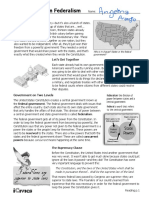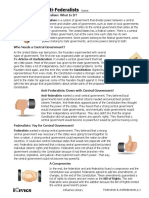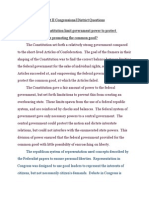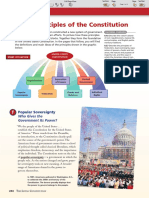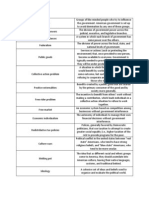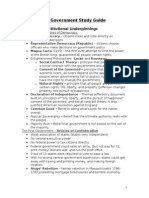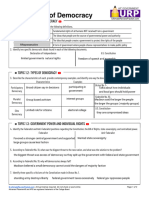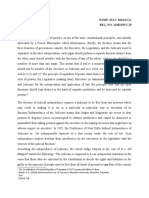Professional Documents
Culture Documents
Chapter 2
Chapter 2
Uploaded by
conorfrizelle4Copyright
Available Formats
Share this document
Did you find this document useful?
Is this content inappropriate?
Report this DocumentCopyright:
Available Formats
Chapter 2
Chapter 2
Uploaded by
conorfrizelle4Copyright:
Available Formats
AP Government Name: Conor Frizelle
Murphy Date Completed: 10/8
Assignment: Chapter 2 – The Constitution
Vocabulary/Definitions: AP Government is a vocabulary-heavy class. As such, you are expected to have working
definitions – preferably in your own words - of all of the words listed for each chapter.
Vocabulary: Your Definition
Constitution A document that outlines how a government will rule and what that will look like
Republic A government run by the people by representatives
Articles of Confederation Attempted to create the first union of the 13 colonies, emphasized state power
Unicameral One housed
Shay’s Rebellion Uprising against Massachusetts by farmers that fought in the war and were mad they
weren’t getting paid
Constitutional Convention A meeting that was going to fix the AoC, created the constitution as we know it today
Writ of habeus corpus A right of the people that, when detained, they should know what charges are against
them
Bill of attainder When a legislature decides someone is guilty without a trail
Ex post facto laws Laws punishing people for acts that were not crimes while they were committing them
Virginia plan 3 branches, bicameral legislature, basically house of reps
New jersey plan Unicameral, basically the senate
Grand committee Worked out a way to find a compromise between the two ideas
Great compromise Created the way the government is structured today, name of the compromise found
Bicameral Two housed
3/5 compromise The compromise found between slave states and non-slave states that gave a slave
3/5s of the representation in a state
Compromise on Unrestricted slave trade until 1808
importation
Separation of powers The design of the government that distributes power across institutions to avoid
tyranny
Checks and balances Each branch of government has powers that can prevent the other branches from
making policies
Federalism The idea of sharing power between national government and state government
Legislative branch Responsible for making laws
Expressed/enumerated Authority explicitly granted to a branch from the constitution
powers
Necessary and proper The exact language from the constitution that granted congress power to do what it
clause needs to do
Implied powers When the authority of the federal government goes beyond its expressed powers
Executive branch Carries out what the legislative branch does
Judicial branch Decides what is constitutional and not
Supremacy clause Creates the supreme law of the land, that the constitution and other treaties are the
most important and need to be followed everywhere that the gov has jurisdiction
Amendment The way changes are made to the constitution
Federalists The people who support federalism, called for a strong national government
Anti-federalists People that are against federalism, called for a weak national government
Federalist papers A bunch of essays that explain why the constitution works the way that it does
Faction A group of selfish people that will do whatever it takes to get what they want
Federalist 10 Argues that the dangers of factions can be avoided through proper use of a republic
governmental style
Federalist 51 Argues that separation of powers and the rest of federalism ideas will prevent tyranny
Brutus 1 The name of an antifederalist paper that argued that the US was too big to be
governed by a republic (spreading misinformation irl 🐬🐬🌈🌈)
Using the Content: Write a response to the prompts for each section of the reading. Each of the following is written in
the style of an AP prompt, and – when responded to appropriately – will require you to utilize the content of the
associated section. Make sure to correctly use the vocabulary and content from the book in your responses.
Section 2.1:
1. Explain how specific weaknesses in the Articles of Confederation led to the proposal for a new, stronger
federal government.
Weaknesses in the Articles of Confederation led to fear among the elite and the people that the government was
not strong enough to actually do anything. For example, Shay’s rebellion illustrated how the government was
incompetent when attempting to raise an army. When the farmers initially rebelled, they made it quite a long way
through the countryside of Massachusetts, with little to no opposition. The elites were fearful that they would
cause enough harm to incite another revolution, so they put them down with their large amounts of money. This
was quite frightening for the national government, as their inability to do anything put on display their
incompetence. Another example of how the AoC was too weak can be found in taxes. They couldn’t enforce tax
collection at all. The national government was not able to receive an adequate amount of taxes. This is problem is
self-explanatory, and after the 5 years that the AoC existed, they only received 1/6 of the amount they asked for.
Section 2.2:
1. Using examples from the reading, explain how the Constitution was shaped by negotiation and compromise.
At the constitutional convention, the constitution was constantly argued about and debated over, and this led to
the extreme amounts of compromise that is in it. For example, the great compromise came to be through the
arguments from those who believed in the New Jersey plan and the Virginia plan. After debating and arguing for
many days, the grand committee was able to incorporate the most important ideas from both sides of the
argument, and thus was able to shape the constitution. Another example is the 3/5 compromise. It states that a
slave shall be worth 3/5 of a person in terms of representation for the house of representatives. This number,
although odd, was determined by the likes of negotiation and compromise between slave states and free states.
Similar to the great compromise, they debated about this for days, and were eventually able to agree on a number
to be added into the constitution, thereby shaping it.
Section 2.3:
1. Describe the system of checks and balances and separation of powers.
Checks and balances and separation of powers are both actions that attempt to reduce the chance of tyranny
occurring in the US. For example, in congress when they pass a bill, they need approval from both houses first. Just a
simple majority, then it goes to the president to sign it into existence. If he decides to veto it, then the houses can
override the veto with a super majority. This idea of checks and balances also applies to the separation of powers.
When the legislative branch creates a law, their job is done. It now falls to the executive branch to enforce it, but if
people start questioning the law, then the judicial branch has to affirm that it is constitutional.
2. Explain the impact of checks and balances on the political system.
The impact of checks and balances on the political system means that a minority party can still have an impact
on the government. For example, if a president is democrat and the legislative branch is republican, then it is
obvious that both parties play a big role in politics at the time. This means that both will have influence on the
government, and this is due to how checks and balances play out in the political system.
Section 2.4:
1. Compare and contrast the arguments presented by the Federalists and Antifederalists during the ratification
debates.
Federalist and anti-federalist arguments were similar in the way that they both called for a stronger national
government, as that was the obvious flaw in the Articles of Confederation at the time. The fact that the national
government had literally zero power was something that both parties wanted to change. However, the arguments
presented by both parties were mostly contrasting. The federalists wanted to swing the pendulum of national
power closer to the strong side, where they believed that having a strong national government was central to how
a republic would function, whereas the Anti-federalists thought the opposite. In Brutus I they argued that a
country like the United States was too big to have a republic function properly, and that the states needed to be
strong in order to keep the union together.
You might also like
- Ginsberg V New York - Case DigestDocument3 pagesGinsberg V New York - Case DigestgabbieseguiranNo ratings yet
- Chapter 3Document3 pagesChapter 3conorfrizelle4No ratings yet
- FedinFederalismKidPagesforCanvas 30fd46 F1f0afDocument5 pagesFedinFederalismKidPagesforCanvas 30fd46 F1f0afalexNo ratings yet
- Federalism Reading FillableDocument3 pagesFederalism Reading FillableViviana TryfonopoulosNo ratings yet
- Kami Export - J'ORDYN RUCKER - The Federal in FederalismDocument5 pagesKami Export - J'ORDYN RUCKER - The Federal in Federalism1613405No ratings yet
- Masteryproj 1Document11 pagesMasteryproj 1api-295687602100% (1)
- Federalism Icivics LessonDocument2 pagesFederalism Icivics LessonJean-Pierre DelacroixNo ratings yet
- Mario Mancia - Daily Summary Week 4Document6 pagesMario Mancia - Daily Summary Week 4api-544320837No ratings yet
- FederalistDocument7 pagesFederalistEdwin PadrilananNo ratings yet
- Concepts of Federalism: Federalism Unitary Government, ConfederationDocument2 pagesConcepts of Federalism: Federalism Unitary Government, ConfederationDianeNo ratings yet
- Unit II Congressional District Questions Q1: How Does The Constitution Limit Government Power To Protect Individual Rights While Promoting The Common Good?Document10 pagesUnit II Congressional District Questions Q1: How Does The Constitution Limit Government Power To Protect Individual Rights While Promoting The Common Good?api-298524731No ratings yet
- AP Government Study Guide: Unit One: Constitutional UnderpinningsDocument23 pagesAP Government Study Guide: Unit One: Constitutional UnderpinningsddNo ratings yet
- Con LawDocument22 pagesCon LawStacy OliveiraNo ratings yet
- American FederalismDocument14 pagesAmerican FederalismReet MomiNo ratings yet
- All About Usa ConstitutionDocument11 pagesAll About Usa Constitutionkaransinghania615No ratings yet
- Consitution of Usa1Document124 pagesConsitution of Usa1e videosNo ratings yet
- Con Law Study Guide Complete)Document32 pagesCon Law Study Guide Complete)valiantthorNo ratings yet
- Aws 7 Ocr Government and PoliticsDocument28 pagesAws 7 Ocr Government and PoliticsIntroer GratisNo ratings yet
- The Constitutional Context: ConstitutionDocument25 pagesThe Constitutional Context: ConstitutionCristina M AftanNo ratings yet
- Federalism: A Filipino ViewpointDocument67 pagesFederalism: A Filipino ViewpointWilliam Alexander Matsuhara AlegreNo ratings yet
- Federalism: Hugo L BlackDocument2 pagesFederalism: Hugo L BlackSevy MartinNo ratings yet
- Lowi 2017 CH 3 PDFDocument25 pagesLowi 2017 CH 3 PDFJosefinaGomezNo ratings yet
- CONSTITUTIONAL LAW OUTLINE - Phillip Hamburger, Columbia, S22Document63 pagesCONSTITUTIONAL LAW OUTLINE - Phillip Hamburger, Columbia, S22Trevor Rice100% (1)
- Federalist Debate-StudentDocument7 pagesFederalist Debate-StudentKeyton OwensNo ratings yet
- 8.5 Constitution Handbook - Seven Principles of The Constitution PDFDocument4 pages8.5 Constitution Handbook - Seven Principles of The Constitution PDFjohn7astoriaNo ratings yet
- U2 LP4 TextCodingDocument2 pagesU2 LP4 TextCodingcullw1984No ratings yet
- All AP US Government VocabularyDocument37 pagesAll AP US Government VocabularySean McCormac100% (1)
- US's First Constitution Should The Constitution Be RatifiedDocument2 pagesUS's First Constitution Should The Constitution Be RatifiedroyNo ratings yet
- Federalism EssayDocument2 pagesFederalism EssaySevy MartinNo ratings yet
- Branches of Government PaperDocument10 pagesBranches of Government PaperMagda RodriguezNo ratings yet
- AP Government CramDocument31 pagesAP Government CramcuamiNo ratings yet
- Federalism PDFDocument1 pageFederalism PDFHana SongNo ratings yet
- Pol215 r4 Foundations of Us Federal GovernmentDocument6 pagesPol215 r4 Foundations of Us Federal GovernmentJalanie Franklin100% (1)
- Features of Us ConstitutionDocument7 pagesFeatures of Us ConstitutionnaheedNo ratings yet
- Structure of The ConstitutionDocument13 pagesStructure of The Constitutionapi-234437487No ratings yet
- 09 - Chapter 4 PDFDocument102 pages09 - Chapter 4 PDFVinay Kumar KumarNo ratings yet
- Salient Features of Us ConstitutionDocument13 pagesSalient Features of Us ConstitutionAhmad Hassan ChathaNo ratings yet
- Federalist AntifederalistDocument7 pagesFederalist Antifederalistapi-68217851No ratings yet
- Government Exam Review Answer Key USADocument11 pagesGovernment Exam Review Answer Key USADepartamentul Engleză-Franceză de SpecialitateNo ratings yet
- Seven Principles TextDocument6 pagesSeven Principles Textapi-32740845No ratings yet
- What Is The Purpose of The U.S Government ?Document5 pagesWhat Is The Purpose of The U.S Government ?Schmetterling TraurigNo ratings yet
- Research Paper On Us ConstitutionDocument5 pagesResearch Paper On Us Constitutionmkrferqhf100% (1)
- Separation of PowersDocument12 pagesSeparation of PowersArvind MohitNo ratings yet
- Chapter 3Document7 pagesChapter 3Jordan MummeyNo ratings yet
- Pol Sci 2 Res PPR 1Document10 pagesPol Sci 2 Res PPR 1Apoorva KudariNo ratings yet
- Kami Export - The Federalist Debate (HS)Document5 pagesKami Export - The Federalist Debate (HS)JoceNo ratings yet
- MISBAH PATEL - APGovUnit1StudyGuidewwwultimatereviewpacketcom-230109-104332Document3 pagesMISBAH PATEL - APGovUnit1StudyGuidewwwultimatereviewpacketcom-230109-104332misbahpatel0919No ratings yet
- Chapter 9 - Reviewing What You Have LearnedDocument2 pagesChapter 9 - Reviewing What You Have Learnedtramy1409.ctNo ratings yet
- Constitutional Reform PaperDocument3 pagesConstitutional Reform PaperPhilip ArgauerNo ratings yet
- Con Law - Outline 2Document51 pagesCon Law - Outline 2Justin BouchardNo ratings yet
- Us Constitution As A Source of LawDocument5 pagesUs Constitution As A Source of LawFabian PereiraNo ratings yet
- 2019 Redesign Unit 1 Review Packet - Ready To PostDocument8 pages2019 Redesign Unit 1 Review Packet - Ready To Postluketfood101No ratings yet
- 3 1proctorDocument2 pages3 1proctorDiane ProctorNo ratings yet
- UntitledDocument25 pagesUntitledCrazykiddo 307No ratings yet
- Week 3Document5 pagesWeek 3r66kbsksy2No ratings yet
- Professor Amar Emphasizes Two Major Themes in The First Couple Weeks of ClassDocument3 pagesProfessor Amar Emphasizes Two Major Themes in The First Couple Weeks of ClassHitesh Trivedi100% (1)
- Just Right GovernmentDocument6 pagesJust Right Governmentapi-231584882No ratings yet
- Introduction To American Government: The American Democracy In History And ContextFrom EverandIntroduction To American Government: The American Democracy In History And ContextNo ratings yet
- Ruben and Myrna Leynes, vs. Former Tenth Division of The Court of Appeals G.R. No. 154462january 19, 2011Document2 pagesRuben and Myrna Leynes, vs. Former Tenth Division of The Court of Appeals G.R. No. 154462january 19, 2011Gretchen Alunday SuarezNo ratings yet
- VL Order Judge Mary Ann Grilli - Santa Clara County Superior Court - Dong v. Garbe Vexatious Litigant Proceeding Santa Clara Superior Court - Attorney Brad Baugh - Presiding Judge Rise Jones PichonDocument6 pagesVL Order Judge Mary Ann Grilli - Santa Clara County Superior Court - Dong v. Garbe Vexatious Litigant Proceeding Santa Clara Superior Court - Attorney Brad Baugh - Presiding Judge Rise Jones PichonCalifornia Judicial Branch News Service - Investigative Reporting Source Material & Story IdeasNo ratings yet
- Amurao V CADocument2 pagesAmurao V CAOmar sarmientoNo ratings yet
- Sanidad vs. Comelec G.R. No. L-44640 October 12, 1976 Petitioners: Pablo C. Sanidad, Pablito V. Sanidad Respondents: Honorable Commission On Elections and Honorable National Treasurer FactsDocument3 pagesSanidad vs. Comelec G.R. No. L-44640 October 12, 1976 Petitioners: Pablo C. Sanidad, Pablito V. Sanidad Respondents: Honorable Commission On Elections and Honorable National Treasurer FactsNelda EnriquezNo ratings yet
- ONLINE EMEND CLAC 050 Exam SolutionDocument7 pagesONLINE EMEND CLAC 050 Exam SolutionAhmad MohamedNo ratings yet
- Ah Thian V Government of MalaysiaDocument7 pagesAh Thian V Government of MalaysiaRobin WongNo ratings yet
- Lecaroz Vs Sandigandbayan 128 SCRA 324Document4 pagesLecaroz Vs Sandigandbayan 128 SCRA 324Kenley MacandogNo ratings yet
- Topic Date Case Title GR No Doctrine FactsDocument2 pagesTopic Date Case Title GR No Doctrine FactsJasenNo ratings yet
- Urbanes vs. CADocument7 pagesUrbanes vs. CAanajuanitoNo ratings yet
- WESTERN BICUTAN v. MILITARY SHRINE POLIDocument1 pageWESTERN BICUTAN v. MILITARY SHRINE POLILDNo ratings yet
- Updates/Salient Features of Philippine Civil ProcedureDocument17 pagesUpdates/Salient Features of Philippine Civil Proceduresophiegenesis0% (1)
- Error in Charge: Effects of Omission To Frame, or Absence Of, or Error in ChargeDocument4 pagesError in Charge: Effects of Omission To Frame, or Absence Of, or Error in ChargeDeepesh KatariyaNo ratings yet
- Supreme Court: Republic of The Philippines Manila en BancDocument5 pagesSupreme Court: Republic of The Philippines Manila en BancFelibeth Dela Peña LingaNo ratings yet
- Dela Paz V Senate DigestDocument2 pagesDela Paz V Senate DigestDonn LinNo ratings yet
- The State Court of Gwinnett CountyDocument49 pagesThe State Court of Gwinnett Countyjoe100% (2)
- People of The Phils. Vs SoriaDocument2 pagesPeople of The Phils. Vs SoriaCheska Christiana Villarin SaguinNo ratings yet
- Statcon MIDTERMDocument31 pagesStatcon MIDTERMLacesand solesNo ratings yet
- Name: Sia I. Masaga. REG. NO: 11301255/T.19: MteguleDocument5 pagesName: Sia I. Masaga. REG. NO: 11301255/T.19: MteguleMkushi FedarhNo ratings yet
- Article 13 of The Indian ConstitutionDocument9 pagesArticle 13 of The Indian ConstitutionSaharsshNo ratings yet
- Duty To Give Reasons - MP SinghDocument30 pagesDuty To Give Reasons - MP SinghKanyaNo ratings yet
- UwhejsnsDocument79 pagesUwhejsnsBishwa Prakash BeheraNo ratings yet
- Kailash Art International Vs Central Bank of India - AspxDocument56 pagesKailash Art International Vs Central Bank of India - AspxanillegalmailsNo ratings yet
- TC-30 R MemoDocument30 pagesTC-30 R MemoAasthaNo ratings yet
- Necessity: Dynamic Nature of The Constitution. Balance Between Non-Amendable and Easily Amendable ConstitutionDocument14 pagesNecessity: Dynamic Nature of The Constitution. Balance Between Non-Amendable and Easily Amendable ConstitutionarmaanNo ratings yet
- Consti Law Review Digest 1Document49 pagesConsti Law Review Digest 1marydalemNo ratings yet
- MTCCDocument9 pagesMTCCGemma acostaNo ratings yet
- Arnado v. ComelecDocument21 pagesArnado v. ComelecA Febb M. VillarNo ratings yet
- G.R. No. 200191Document1 pageG.R. No. 200191annaNo ratings yet
- Shri IM Nanavati Memorial Moot Court Competition RespondentsDocument26 pagesShri IM Nanavati Memorial Moot Court Competition RespondentsDarshan AwareNo ratings yet


